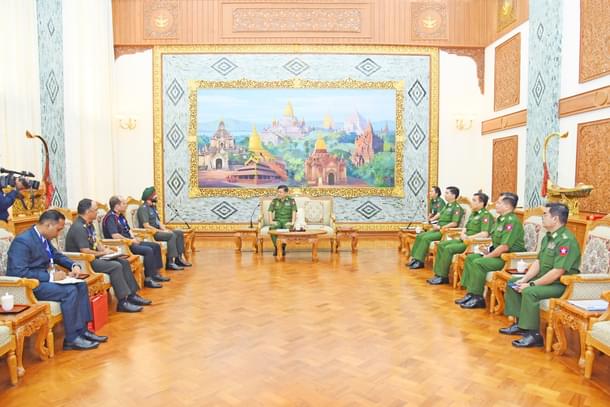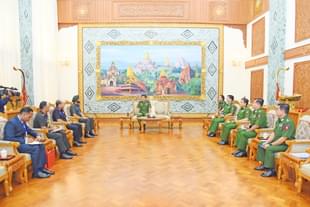World
India’s Fine Balancing Act In Myanmar: Engaging With The Junta And Stepping Up Ties With The Government-In-Exile
Jaideep Mazumdar
Jun 15, 2024, 03:50 AM | Updated Jun 15, 2024, 11:29 AM IST
Save & read from anywhere!
Bookmark stories for easy access on any device or the Swarajya app.


One of the little-known success stories of Indian diplomacy in recent times is the fine balancing act it has been pulling off in Myanmar.
While keeping up its close engagement with the military junta in that country, New Delhi has also quietly stepped up its ties with the country’s National Unity Government (NUG) — the government-in-exile comprising elected lawmakers ousted from power by the country’s military in a bloodless coup in February 2021.
India is the third-largest supplier of military hardware to the junta after China and Russia. Reciprocal visits between the military brass of both countries are routine. The latest was the visit of an Indian Army delegation led by Major General Charanjeet Singh Dewgun, the Joint Director General of Military Intelligence, to the country’s capital on 12 June.
Major General Dewgun and the senior officers accompanying him met Myanmar’s joint commander-in-chief, General Maung Maung Aye (the junta’s number three), and other senior generals.
The two sides are learnt to have discussed measures to step up bilateral military cooperation, especially border management and security, and training missions for Myanmar’s cadet officers.
Top sources in India’s Ministry of Defence (MoD) told Swarajya that the 12 June talks at Naypyitaw (Myanmar’s new capital) were "very fruitful." For India, the most important takeaway was the junta’s agreement to New Delhi’s proposal for "close cooperation to enforce the inviolability of the Indo-Myanmar border," especially along Manipur and Mizoram.
Shorn of the military jargon, this means coordinated efforts between the militaries of the two countries to ensure that the Chin militants operating in the Chin state of Myanmar are curbed, stopped from entering and getting safe refuge in Manipur and Mizoram.
This is a major concern for India, as Chin militants from the neighbouring country have been entering Manipur with sophisticated arms and participating in attacks on security forces, as well as the Meiteis, in Manipur.
Apart from training officer cadets from Myanmar, India has also agreed to train Myanmar’s police in law enforcement. The two sides have also decided to step up bilateral exchanges, including visits by top military and intelligence officers, and diplomats of the two countries.
Two months ago, on 14 May, India’s Assistant Chief of Air Staff (Intelligence), Air Vice Marshal Ichettira Iyappa Kuttappa, met the junta’s air chief, General Tun Aung, and discussed technical assistance that the Indian Air Force can offer to Myanmar’s air force. India also agreed to provide training to pilots and air defence officers from Myanmar.
On 21 February this year, the commander of Indian Army’s 3 Corps (or the ‘Spear Corps’) — based in Rangapahar, near Dimapur in Nagaland — Lieutenant General Harjeet Singh Sahi led a military delegation to Myanmar and met the junta’s number two, Vice Senior General Soe Win.
Major General Than Htaik, the commander of the junta’s North-Western Command, whose area of operations includes the Indo-Myanmar border along Manipur and Mizoram, also participated in the talks that centred on border security.
Senior intelligence officers from India, including Deputy National Security Advisor Vikram Misri, have also visited Myanmar in recent months. Top generals from that country have also been visiting India frequently.
At the same time, India has quietly stepped up its engagement with the NUG. A small group of serving and retired Indian diplomats who have good ties with Myanmar’s ousted politicians, including those from Aung San Suu Kyi’s National League For Democracy (NLD), have been working over the past 10 months to rebuild ties with the NLD and its allies, who are part of the NUG.
Mandarins at India’s Ministry of External Affairs (MEA) decided to establish ties with the NUG after its armed wing, People’s Defence Forces (PDF), started posting successes in small battles with the junta.
In late October last year, the PDF joined forces with ethnic armed organisations (EAOs) of Myanmar to launch joint offensives against the country’s armed forces, also called the ‘Tatmadaw’. The PDF and EAOs have managed to wrest control of many parts of the country, especially along its northern and eastern borders, from the junta.
By the time the anti-junta forces started posting major successes, the Indian side had already established firm links with the NUG. It wasn’t an easy task, though.
"Seniors in the NUG were very unhappy that India has been continuing its engagements with the junta and has been supplying military hardware to them. Many in the NUG had the ‘either you are with us or against us’ attitude, and wanted India to cut off all ties with the junta as a precondition to the NUG holding meaningful discussions with Indian interlocutors," a senior MEA officer told Swarajya.
India’s interlocutors, who included a couple of academicians with close ties to the NLD, had to painstakingly explain New Delhi’s position and compulsions to the NUG leaders.
"It took some time to explain to them that we had to keep up our engagements with the State Administration Council (SAC), as the junta is formally known as. We had to explain that it is important for India, as a neighbour and as a responsible power in the region, to maintain leverage over the generals in Myanmar by engaging with them. Cutting off ties with them would only push them deeper into China’s embrace and that will be counter-productive for everyone, including the NUG," the MEA officer said.
The Indian side also had to explain to the NUG that engagement with the SAC does not mean opposition to the NUG. "These nuances and many other things had to be explained to the NUG leaders. It took time, but they ultimately understood and have come to appreciate our stand," the MEA officer added.
Most of the interactions between the NUG leaders and Indian interlocutors took place in Thailand, and some in a few other nations where the NUG leaders are in exile.
India’s representatives also told the NUG that New Delhi has been encouraging the SAC to hold elections in the country and pave the way for a return to democracy.
"It is always better and more productive to engage with an entity rather than to isolate it. More so, when such isolation will push the junta towards totalitarian powers like China, which will encourage it to be more autocratic and brutal. India’s engagement with the junta will act as a check on the junta and will ultimately prove beneficial to the NUG," said an officer in the MEA’s BM (Bangladesh, Myanmar) Division.
Indian interlocutors have also conveyed to the NUG leadership New Delhi’s grave concern over the activities of Chin militants belonging to the Chin National Army (CNA) and the Chinland Defence Force (CDF), which are associated with the PDF (the NUG’s military wing).
"The illegal entry of CNA and CDF militants armed with lethal weapons into Manipur to carry out operations there (Manipur) has been conveyed to the NUG leaders. They have been requested to prevail on the two outfits to stop their anti-India activities and to stop entering Manipur," said the MEA officer.
India’s simultaneous successes in keeping up its engagement with Myanmar’s ruling junta and also establishing ties with the NUG has been a major diplomatic victory for the country. Few other countries can boast of walking such a tightrope so successfully and with such finesse.




